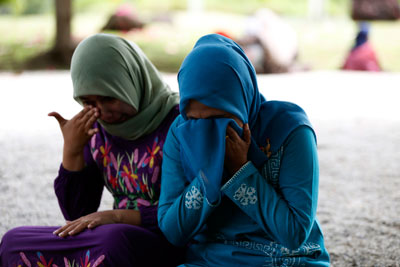Sunday Times 2
Candles, prayers and tears as Asia mourns tsunami dead 10 years on
KHAO LAK, Thailand, Dec 26, (AFP) – Tearful mourners lit candles on Friday to remember the 220,000 people who died a decade ago when tsunami waves devastated coastal areas along the Indian Ocean, in one of the worst natural disasters in human history.
On December 26, 2004 a 9.3-magnitude earthquake off Indonesia’s western tip generated a series of massive waves that pummelled the coastline of 14 countries as far apart as Indonesia, Thailand, Sri Lanka and Somalia.

Acehnese women cry as they pray at a tsunami mass graveyard in Banda Aceh on Friday. Reuters
Among the victims were thousands of foreign tourists enjoying Christmas on the region’s sun-kissed beaches, carrying the tragedy of an unprecedented natural disaster into homes around the globe.
In southern Thailand, where half of the 5,400 dead were holidaymakers, people recounted stories of horror and miraculous survival as the churning waters, laden with the debris of eviscerated bungalows, cars and boats, swept in without warning, obliterating resorts and villages.
A minute’s silence in the resort of Khao Lak, much of which was washed away by the towering waves, was broken by a lone trumpeter, as mourners each lit a single white candle, some sobbing as they illuminated the darkness.
Among them was a Swiss national, Katia Paulo, who lost her boyfriend on a nearby beach.
“I had my back to the ocean. My boyfriend called me… the only thing I remember is his face.I knew I had to run away, then the wave caught me,” the 45-year-old told AFP.
“I was pushed under water many times and thought it was the end,” she said.
She called for help, only to realise the people nearby were already dead.
“I managed to hold onto a tree branch,” she said. As the waves retreated, she was six metres (200 feet) off the ground.
Nearby, 40-year-old Somjai Somboon was grieving for her two sons, who were ripped from their house when the waves cut into their fishing village of Ban Nam Khem.
“I remember them every day,” she said, with tears in her eyes.
“I will always miss my sons.” Hundreds of people also lit candles on Patong beach on Phuket island after observing a minute’s silence.Afterwards, many placed the candles into a sand sculpture created by students as part of the memorial service.
Among the international commemorations, in Sweden, which lost 543 citizens, the royal family and relatives of the victims attended a memorial service in Uppsala Cathedral.
“Sweden is still traumatised,” said Prime Minister Stefan Lofven, who paid tribute to all who died, saying their “lives were extinguished but the memory of their love shines in the night”.
There was no warning of the impending tsunami, giving little time for evacuation, despite the hours-long gaps between the waves striking different continents.
In 2011 a pan-ocean tsunami warning system was established, made up of a network of sea gauges, buoys and seismic monitors, while individual countries have invested heavily in disaster preparedness.
But experts have cautioned against “disaster amnesia” creeping into communities vulnerable to natural disasters.
The scale of the devastation in 2004 saw nations initially struggle to mobilise a relief effort, leaving bloated bodies to pile up under the tropical sun or in makeshift morgues.
The world poured money and expertise into the relief and reconstruction, with more than $13.5 billion collected in the months after the disaster.
Almost $7 billion in aid went into rebuilding more than 140,000 houses across Indonesia’s Aceh province, where most of the nation’s 170,000 victims were claimed.
In the main city, Banda Aceh, several thousand mourners gathered in a park for the nation’s official remembrance.
It was near the epicentre of the undersea quake and bore the brunt of waves towering up to 35-metres (115 feet) high.
“Thousands of corpses were sprawled in this field,” Indonesian Vice President Jusuf Kalla told the crowd, many amongthem weeping.
“There were feelings of confusion, shock, sorrow, fear and suffering. We prayed.
“And then we rose and received help in an extraordinary way,” he said, hailing the outpouring of aid from local and foreign donors.
The disaster also ended a decades-long separatist conflict in Aceh, with a peace deal between rebels and Jakarta struck less than a year later.
Mosques held prayers across the province, while people visited mass graves — the resting place of many of Indonesia’s tsunami dead.
But a Red Cross display of hundreds of salvaged ID documents and bank cards served as a grim reminder that many victims simply vanished.
In Sri Lanka, where 31,000 people perished, survivors and relatives gathered to remember around 1,000 victims who died when waves derailed a passenger train.
The mourners boarded the restored Ocean Queen Express and headed to Peraliya — the exact spot where it was ripped from the tracks, around 90 kilometres (56 miles) south of Colombo.
(Please see ST2 Page 1 and
Plus Page 1)

